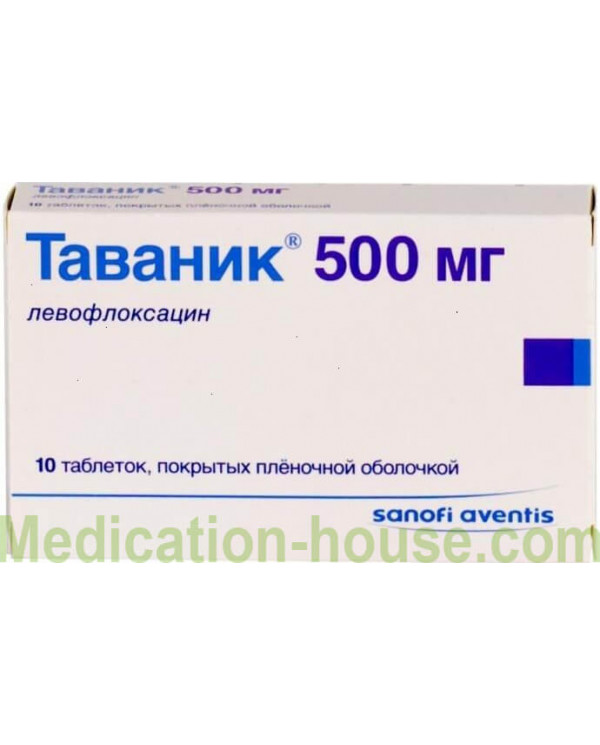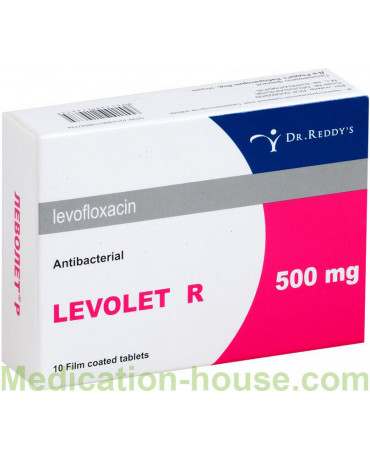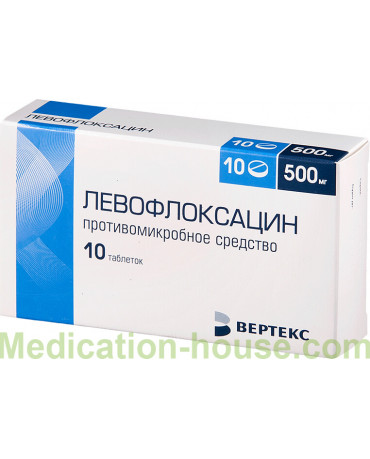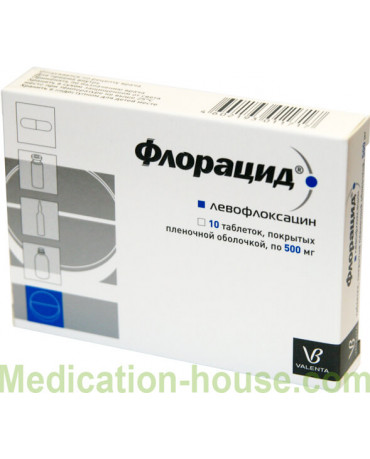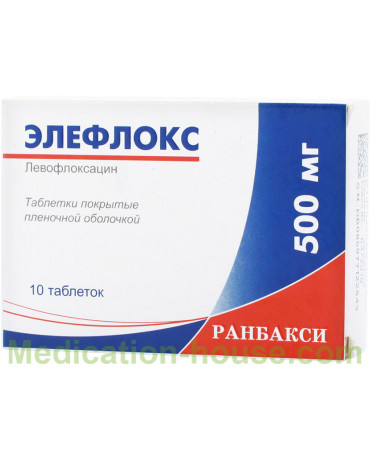Tavanic instruction
You can buy Tavanic here
Tavanic is a proprietary synthetic antimicrobial agent that represents a group of fluoroquinolones.
Pharmacologically active substance in the composition of tavamine, its driving therapeutic force is the levorotatory isomer of ofloxacin - levofloxacin, which has a broad spectrum of activity and is active against most known virulent strains of microorganisms.
Ingredients 1 tablet:
active ingredient: levofloxacin (in the form of levofloxacin hemihydrate) - 250 mg or 500 mg;
auxiliary components: crospovidone, sodium stearyl fumarate, hypromellose, microcrystalline cellulose;
film cover: macrogol 8000, talc, hypromellose, dye iron oxide yellow, titanium dioxide, dye iron oxide red.
pharmachologic effect
The antibiotic Levofloxacin affects the processes of DNA supercoiling of harmful bacteria cells. Synthesis of protein, DNA and RNA is inhibited, which leads to the inevitable death of pathogenic microorganisms.
It should be noted that levofloxacin is much stronger than ofloxacin. Means shows bactericidal activity in relation to aerobic, anaerobic, gram-positive and - negative microorganisms. In particular, cocci, streptococci, various intracellular pathogens, hemophilus bacilli, enterobacteria and pancinoma. The antibiotic is practically useless against the strains of Staphylococcus aureus, Salmonella, Shigella, Enterococcus, Gonococcus, Pseudomonas, some strains of pneumococci.
In the patient's body quickly (2 hours) penetrates almost all organs affected by bacteria. It is usually excreted by the kidneys within 6-8 hours. In people with kidney disease, pharmacokinetic parameters may vary.
Indications for use
Tablets and solution for infusion Tavanic have the same indications for use, because the antibiotic is active against the same microorganisms.
Tavanic is indicated for use in the treatment of the following infections, which are caused by bacteria that are susceptible to it:
Acute sinusitis;
Pneumonia;
Infections of the abdominal organs;
Stage of exacerbation of chronic bronchitis;
Chronic prostatitis bacterial nature;
Infectious diseases of the skin and soft tissues (for example, muscles, ligaments, etc.);
Sepsis (blood infection) associated with any of the above infections;
Uncomplicated and complicated infectious diseases of the urinary tract (cystitis, urethritis, pyelonephritis, etc.);
In the complex therapy of resistant forms of tuberculosis.
Contraindications
The drug Tavanic has absolute and relative contraindications to use. If there are absolute contraindications, the antibiotic cannot be taken under any circumstances. And in the presence of relative contraindications Tavanic can be used, but with the observance of caution and under close medical supervision of the human condition.
The absolute contraindications to the use of Tavanic are the following conditions:
gestation period;
breast-feeding;
epilepsy;
tendonitis caused by the use of any systemic quinolone (for example, Ciprofloxacin, Ofloxacin, etc.) in the past;
age under 18;
allergy, hypersensitivity or intolerance to the components of tavanic.
Relative contraindications to the use of tavanic are the following states:
myocardial infarction;
bradycardia (reduction of heart rate);
taking glucose-lowering drugs (for example, Glibenclamide or Insulin) for diabetes;
the presence of severe adverse reactions in response to the use of any other drugs from the group of fluoroquinolones (for example, Ciprofloxacin or Ofloxacin, etc.);
increased convulsive readiness (for example, people who have had a stroke in the past, or who take Fenbufen and Theophylline in the present);
deficiency of the enzyme glucose-6-phosphate dehydrogenase;
renal failure;
low concentration of magnesium or potassium;
chronic heart failure;
presence of pseudo-paralitic myasthenia.
Appointment during pregnancy and lactation
Tavanic is contraindicated for use in the treatment of women during pregnancy and breastfeeding. In the course of the laboratory studies it was found that the active active ingredient of the drug can lead to the formation of congenital developmental anomalies.
If it is necessary to treat a nursing mother with a drug, the issue of stopping lactation should be resolved, since the active ingredient of the drug Tavanic is excreted in breast milk.
Dosage and method of use
As indicated in the instructions for use Tavanic taken orally 250 or 500 mg 1 or 2 times / day. Tablets should be swallowed without chewing and drinking plenty of liquid (from 0.5 to 1 cup). If necessary, tablets can be broken down along the separation groove.
The drug can be taken before meals or at any time between meals, because food intake does not affect the absorption of the drug. Tavanic should be taken not less than 2 hours before or 2 hours after taking antacids containing magnesium and / or aluminum, zinc, iron salts or taking sucralfate.
The dosage regimen is determined by the nature and severity of the infection, as well as the sensitivity of the suspected pathogen. The duration of treatment varies depending on the course of the disease.
Patients with normal renal function (CK> 50 ml / min) are recommended the following dosing regimen and duration of treatment:
Pyelonephritis: 2 tab. 250 mg 1 time / day or 1 tab. 500 mg 1 time / day (respectively, 500 mg of levofloxacin) - 7-10 days.
Chronic bacterial prostatitis: 2 tab. 250 mg or 1 tab. 500 mg 1 time / day (respectively, 500 mg of levofloxacin) - 28 days.
Infections of the skin and soft tissues: 2 tab. 250 mg or 1 tab. 500 mg 1-2 times / day (respectively, 500-1000 mg of levofloxacin) - 7-14 days.
Acute sinusitis: 2 tab. 250 mg or 1 tab. 500 mg 1 time / day (respectively, 500 mg of levofloxacin) - 10-14 days.
Exacerbation of chronic bronchitis: 2 tab. 250 mg or 1 tab. 500 mg 1 time / day (respectively, 500 mg of levofloxacin) - 7-10 days.
Community-acquired pneumonia: 2 tab. 250 mg or 1 tab. 500 mg 1-2 times / day (respectively, 500-1000 mg of levofloxacin) - 7-14 days.
Uncomplicated urinary tract infections: 1 tab. 250 mg 1 time / day (respectively, 250 mg of levofloxacin) - 3 days.
Complicated urinary tract infections: 2 tab. 250 mg 1 time / day (250 mg of levofloxacin, respectively) or 1 tab. 500 mg 1 time / day (respectively, 500 mg of levofloxacin) - 7-14 days.
Prevention and treatment of anthrax during airborne infection: 2 tab. 250 mg or 1 tab. 500 mg (respectively, 500 mg of levofloxacin) 1 time / day - up to 8 weeks.
In the complex therapy of drug-resistant forms of tuberculosis: 1 tab. 500 mg 1-2 times / day (respectively, 500-1000 mg of levofloxacin) - up to 3 months.
Given that the bioavailability of levofloxacin when using the drug Tavanic in tablets is 99-100%, in the case of transferring a patient from iv administration of the drug to tablets, the treatment should be continued at the same dose that was used during IV infusion.
In case of impaired renal function (QC 50 ml / min and below), the dosage regimen of tablets and Tavanic solution is adjusted individually, taking into account the amount of QC and the clinical indications of the patient:
CC 50–20 ml / min: the first dose is 250 mg, then 125 mg 1 time per day; the first dose is 500 mg, then 250 mg 1 or 2 times a day;
CC 19–10 ml / min: the first dose — 250 mg, then 125 mg 1 time every 2 days; the first dose is 500 mg, then 125 mg 1 or 2 times a day;
QC less than 10 ml / min [including continuous ambulatory peritoneal dialysis (CAPD) and hemodialysis]: the first dose is 250 mg, then 125 mg 1 time every 2 days; the first dose is 500 mg, then 125 mg once a day.
After hemodialysis or CAPD, an additional drug is not required.
In case of impaired liver function and elderly patients, the adjustment of the dosage regimen Tavanic is not required.
If the drug is accidentally missed, it is necessary to take a pill as soon as possible and continue to take Tavanic according to the recommended dosing regimen.
Side effect
The use of the drug Tavanic may cause the following side effects:
Digestive system: often - nausea, vomiting; infrequently - flatulence, dyspepsia, constipation, abdominal pain.
Respiratory system: infrequently - shortness of breath; frequency is unknown - allergic pneumonitis, bronchospasm.
Musculoskeletal system: rarely - muscle weakness, tendon damage, including tendonitis.
Immune system: rarely - angioedema; infrequently - urticaria.
Mental disorders: often - insomnia; rarely, depression, sleep disorders, agitation (agitation), nightmares, mental disorders (paranoia, hallucinations).
Biliary tract and liver: often - increased activity of AST, ALT, GGT, ALP; infrequently - an increase in the level of bilirubin in the blood.
Labyrinth disorders and organ of hearing: rarely - tinnitus.
Subcutaneous tissue and skin: infrequently - hyperhidrosis, urticaria, rashes, itching.
Central nervous system: often - dizziness, headache; infrequently - dysgeusia (taste perversion), tremor, drowsiness.
Cardiovascular system: rarely - decrease in blood pressure, palpitations, sinus tachycardia.
Hematopoietic system: rarely - thrombocytopenia, neutropenia; infrequently - eosinophilia, leukopenia.
Organ of vision: rarely - visual impairment, uveitis, transient loss of vision - frequency unknown.
Parasitic and infectious diseases: infrequently - the development of resistance of pathogenic microorganisms, fungal infections.
Metabolism: rarely - hypoglycemia, especially in patients with diabetes mellitus (possible signs of hypoglycemia: nervousness, tremors, sweat, "wolf" appetite); infrequently - anorexia; frequency is unknown - hypoglycemic coma, hyperglycemia.
Urinary tract: rarely - severe renal failure (for example, as a result of the development of interstitial nephritis); infrequently - an increase in serum creatinine level.
General reactions: rarely - pyrexia (fever); infrequently - asthenia.
Additionally for infusion solution: the reaction at the injection site (hyperemia, skin soreness).
Overdose
In the case of the use of the drug Tavanic uncontrollably and in large doses, the patient develops signs of overdose, characterized by increased side effects described above, the development of acute renal and hepatic insufficiency, malfunctions of the heart and central nervous system.
With the development of signs of an overdose, the patient should be immediately taken to the hospital, where he is washed in the stomach, injected into the enterosorbent and, if necessary, symptomatic treatment is carried out.
special instructions
As during the treatment with other antibiotics, when Tavanic is used (especially for a long time), it is possible that the microorganisms that are insensitive to levofloxacin can increase their reproduction, leading to superinfection. In order to avoid such situations, periodically, during the period of therapy, it is necessary to re-evaluate the patient’s condition so that appropriate measures are taken in time for the development of superinfection.
With nosocomial infections caused by Pseudomonas aeruginosa (Pseudomonas aeruginosa), it may be necessary to conduct a combination therapy.
Tavanic can affect psychomotor and cognitive functions (cause drowsiness, dizziness and visual disturbances, reduce the speed of reactions and the ability to concentrate), which should be taken into account for drivers of vehicles and patients engaged in potentially hazardous industries.
Interaction with other drugs
The drug Tavanic is prescribed with caution with the following drugs: theophylline, fenbufen, nonsteroidal anti-inflammatory drugs, indirect anticoagulants (regular monitoring of blood coagulation parameters is required), cimetidine and probenecid (especially in patients with renal insufficiency), cyclosporin, glucosecorticosteroids (in the survey, it has also performed, you can use Cyclosporine,), cyclosporine, it is the same, you can use Cyclosporin, or you can use Cyclosporinoscidoxidine, and you can use Cyclosporine (Cycleporine), you can use Cyclosporinoscidoscidine (Zyxidine). ), extending the interval QT drugs (macrolides, tricyclic antidepressants, antipsychotics, antiarrhythmic drugs of class IA and III).
Reviews
We offer you to read the reviews of people who used the drug Tavanic:
Tatyana
Tavanic pills were attributed to me by a urologist .. After the first pill ... Terrible stomach pains ... The kidneys hurt and it was generally very bad ... I don't know ... Maybe it would be easier if taken with a probiotic ... But I could not ... There are a lot of side effects .. And all they work ...
Anna
My husband was diagnosed with pneumonia. Foci were very large. Breathing is intermittent and painful. The therapist prescribed “Tavanic” as a strong antibiotic. The course was 10 days, but after 4 days the lesions began to decrease! After the course of pneumonia, only a dry cough remained. It is very convenient that the drug is not tied to food. Disadvantages - dry mouth.
Galina
It helped me a lot, bronchitis, severe wheezing, coughing scored a month and a half, I could not sleep. Although I was allergic to almost all antibiotics, this drug immediately took off the cough, I began to breathe deeply, and even my cough ribs ached, my sputum stopped This is an antifungal medication, maybe the wrong diagnosis didn’t help you. On the contrary, sleep returned to normal, and the sputum was coughing up 2-3 times before taking it. I am hypotonic, the pressure is always low, I usually sit on coffee, I also didn’t notice a strong decrease, I could have slept for an hour or two more, but this was attributed to a reduction in coughing, even if I had enough sleep.
Terms of sell
You don't need a prescription to buy Tavanic.

